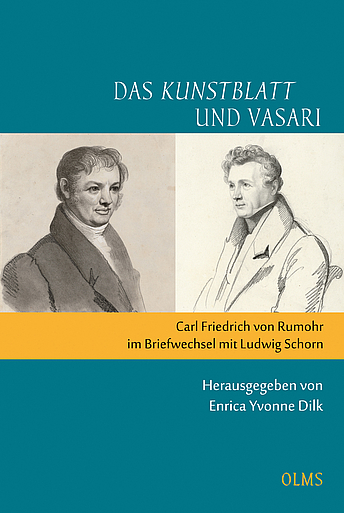Dilk
Das "Kunstblatt" und Vasari
ISBN 978-3-487-15918-8
englischCarl Friedrich von Rumohr’s letters to the editor of Cotta’s Kunstblatt, Ludwig Schorn, offer new insights into the shared journalistic interest which united the two correspondents in the context of an active German-Italian cultural transfer. The letters reproduced here (1820-1832) document their mutual engagement with artistic practice and theory in conjunction with the essays that Rumohr was publishing in Schorn’s journal during the same period. They show how dynamically he influenced the programme of the Kunstblatt, which even in the initial phase of its development was becoming a journal for literature about art. The correspondence, augmented by other documents, also provides insights into the working practices of a connoisseur for whom the polemical form was a constructive impetus to bring “gain to the practical study of art”. This is particularly evident in Rumohr’s confrontations with Johann David Passavant and Johann Dominik Fiorillo over the Nazarenes’ reverence for the Middle Ages and the Classicists’ standards of beauty. Also reflected is the recognition that Schorn gave his influential collaborator as an original researcher, stylistic critic and Vasari expert, who also helped him with the preparation of the first complete German edition of Vasari’s Lives (vol. 1, 1832). In his historiographical essays for the Kunstblatt, which he mainly wrote from his lodgings in Florence, one of Rumohr’s chief concerns was to underpin his theses on the elucidation of the early phases of Italian painting with visual documentation. These preliminary studies grew into his major work Italienische Forschungen (1827-1831). This would open the way into the archives for younger colleagues such as Johannes Gaye, Alfred Reumont and Heinrich Wilhelm Schulz, and was a significant contribution to the development of art history studies based on original documents.
Carl Friedrich von Rumohrs Schreiben an den Cotta‘schen "Kunstblatt"-Redakteur Ludwig Schorn geben Einblicke in eine publizistische Interessengemeinschaft, die die beiden Briefpartner vor dem Hintergrund eines regen deutsch-italienischen Kulturtransfers verband: Die hier mitgeteilten Briefe (1820-1832) dokumentieren deren gemeinsames Engagement für die Kunstpraxis und -theorie im Zusammenspiel mit den Beiträgen, die Rumohr zeitgleich in Schorns Journal publizierte. Es wird nachgezeichnet, wie tatkräftig er auf das Programm des "Kunstblatts" einwirken konnte, das sich schon in der Aufbauphase zum Fachorgan der Kunstliteratur entwickelte. Die anhand ergänzender Dokumente abgerundete Brieffolge gewährt auch Einsicht in die Werkstatt eines Connaisseurs, für den Polemik eine konstruktive Triebfeder war, um der 'practischen Kunstlehre Gewinn' zu bringen. Dies geht insbesondere aus Rumohrs Konfrontation mit Johann David Passavant und Johann Dominik Fiorillo um die Mittelalterverehrung der Nazarener und die schönheitlichen Normen der Klassizisten hervor. Ferner spiegelt sich die Anerkennung wider, mit der Schorn seinem impulsgebenden Mitarbeiter als Quellenforscher, Stilkritiker und Vasari-Kenner begegnete, welcher ihm auch bei der Bearbeitung der ersten deutschen Gesamtausgabe der "Vite" (Bd. I, 1832) Beistand leistete. In den "Kunstblatt"-Beiträgen historiographischen Inhalts, die Rumohr weitgehend in seinem Standquartier Florenz verfasste, war es ihm ein zentrales Anliegen, die Thesen zur Erhellung der Frühstufe italienischer Malerei durch ein visuelles Dokumentationsmaterial zu untermauern. Aus diesen Vorstufen erwuchs das Hauptwerk "Italienische Forschungen" (1827-1831): Es sollte jüngeren Fachkollegen, wie Johannes Gaye, Alfred Reumont und Heinrich Wilhelm Schulz, den Weg in die Archive bahnen und wesentlich zur Entfaltung einer urkundlich begründeten Kunstgeschichte beitragen.


